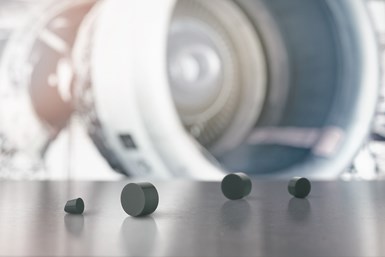Secomax CW100 Ceramic Insert Ensures Stable,Predictable Tool Life
Appears in Print as: 'Ceramic Insert Ensures Stable,Predictable Tool Life'
Insert boosts machining speeds when working with heat-resistant superalloys.
Edited by Angela Osborne

Secomax CW100 Ceramic Insert
Seco Tools has expanded its line of Secomax CW100 ceramic insert grade for manufacturers seeking solutions to unpredictable tool life and slow rough-machining speeds when working with heat-resistant superalloys (HRSA). Featuring new geometries for whisker-reinforced ceramic, the company says this line of ceramic solutions offers superior performance for challenging aerospace, oil and gas, and power generation applications involving Inconel 718, Hastelloy, Waspaloy, MAR, Nimonic, Rene, Udimet and other HRSAs.
The CW100 grade expansion encompasses four round insert formats with two geometries — E-01020 and T-01020 — and four grooving insert geometries with widths of 3.175 mm (0.125"), 6.35 mm (0.25") and 7.925 mm (0.312"). An aluminium-oxide-based grade with silicon-carbide whiskers (Al2O3-SiC), the Secomax CW100 grade boosts machining speeds in advanced HRSA materials, while ensuring stable and predictable tool life thanks to the silicon-carbide whiskers, which use optimized microgeometries for high ceramic wear resistance and strength.
RELATED CONTENT
-
Collets Vs. Chucks
Find the definition, types and advantages of both CNC collets and chucks for workholding as well as the best applications for each, in this article.
-
Calculating Surface Footage and RPM for Optimum Tool Life
Tech Brief: Calculating Surface Footage and RPM for Optimum Tool Life
-
Advantages of Cellular Manufacturing
Manufacturing cells are used to minimize product movement as well as materials, equipment and labor during the manufacturing process. By reducing cycle times and material handling, these cells help shops more easily meet customer demands regarding cost, quality and leadtimes.



